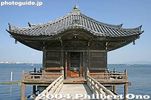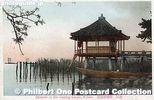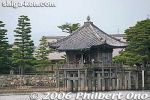 Image search results - "ukimido" Image search results - "ukimido" |

Entrance to Ukimido Floating Temple, which is actually Mangetsu-ji temple. Admission is 300 yen. Hours: 8 am - 5 pm. Buses run from Katata Station. Parking available. 満月寺 浮御堂 MAP
|
|

Ukimido floating temple in Katata, one of Shiga's most famous and picturesque buildings. One of the eight Omi Hakkei Views made famous by ukiyoe prints by Hiroshige.
|
|

The scenic Ukimido has been the subject of ukiyoe woodblock prints (see below) by Hiroshige and other artists. You can walk on the short bridge to the Ukimido.
|
|

The Ukimido building itself has been rebuilt a few times over the centuries. It was first built in the 10th century by Priest Eshin (Genshin 源信) from Enryakuji temple on Mt. Hiei. The current temple building was built in 1937 and renovated in 1982.
|
|

View from the bridge to Ukimido Floating Temple, Katata, Shiga. The building houses altars and 1,000 small Amida Buddha figures supposedly carved by Priest Enshin. Dedicated to transportation safety on the lake.
|
|

View from the balcony.
|
|

Bridge from shore
|
|
|

Balcony looking toward Lake Biwa
|
|

Concrete stilts reinforce the wooden stilts.
|
|

Balcony facing the lake.
|
|

View of Lake Biwa from Ukimido. The Biwako Ohashi Bridge can be seen in the distance.
|
|

Altar facing the lake.
|
|

Altar facing the lake, with some of the 1,000 Amida Buddha figures.
|
|

Altar facing the shore
|
|

North side of Ukimido. Haiku poet also visited Ukimido and wrote a haiku poem about it, displayed on a stone monument on shore.
|
|

Ukiyoe woodblock print by Hiroshige showing "Descending Geese at Katata" with Ukimido in the foreground. 近江八景「堅田の落雁」
|
|

Another ukiyoe woodblock print by Hiroshige showing "Descending Geese at Katata" with Ukimido in the background. 近江八景「堅田の落雁」
|
|

Concrete stilts. Compare this with the next postcard image.
|
|

Vintage postcard of Ukimido floating temple before 1937 when the building was rebuilt. Flimsy stilts in comparison.
|
|

Ukimido as seen from the lake.
|
|

Narita-san Park's Ukimido Floating Hall
|
|

Narita-san Park's Ukimido Floating Hall
|
|
|

Narita-san Park's Ukimido Floating Hall
|
|
|

Another major sight in Lake Toya is the Ukimido pagoda in northern Lake Toya.
|
|

Ukimido pagoda juts out into the lake on a narrow islet connected by a stone bridge.
|
|

Ukimido means "floating view temple."
|
|

Cherry blossoms and Ukimido pagoda.
|
|

Well-placed sculpture at Ukimido: Dream Toya, by Mitsuaki Sora, 空 充秋「夢洞爺」
|
|

Ukimido Park
|
|

The Ukimido is the focal point of the lakeside Ukimido Park.
|
|

A path of stones lead to the Ukimido.
|
|

Around 1912, a Buddhist priest traveling north reached Toya village and rested at the Matsuhashi home. He gave a statue of Prince Shotoku Taishi to the family and said that they and the village shall prosper by taking care of it.
|
|

The Matsuhashi family later moved away from Toya village and entrusted the statue to a local temple.
|
|

Upon the wishes of the local people, they built the Ukimido pagoda in 1937 and put the Shotoku Taishi statue on the altar inside. They also started the annual Shotoku Taishi Festival every July.
|
|

However, on Oct. 15, 2003, the Ukimido was struck by lightning and both the building and Shotoku Taishi statue were lost in the fire.
|
|

Local residents then launched a project to rebuild the Ukimido and through numerous donations, a new Ukimido and Shotoku Taishi altar statue was completed in July 2004.
|
|

Ukimido pagoda, Lake Toya, Hokkaido 浮見堂
|
|

Right side of Ukimido pagoda, Lake Toya.
|
|

Left side of Ukimido pagoda, Lake Toya
|
|

Behind Ukimido pagoda, Lake Toya
|
|

The Ukimido houses a small statue of Prince Shotoku Taishi. Inside, it still looks quite new.
|
|

View from the Ukimido's tiny balcony.
|
|

Ukimido
|
|
|
|
|
|